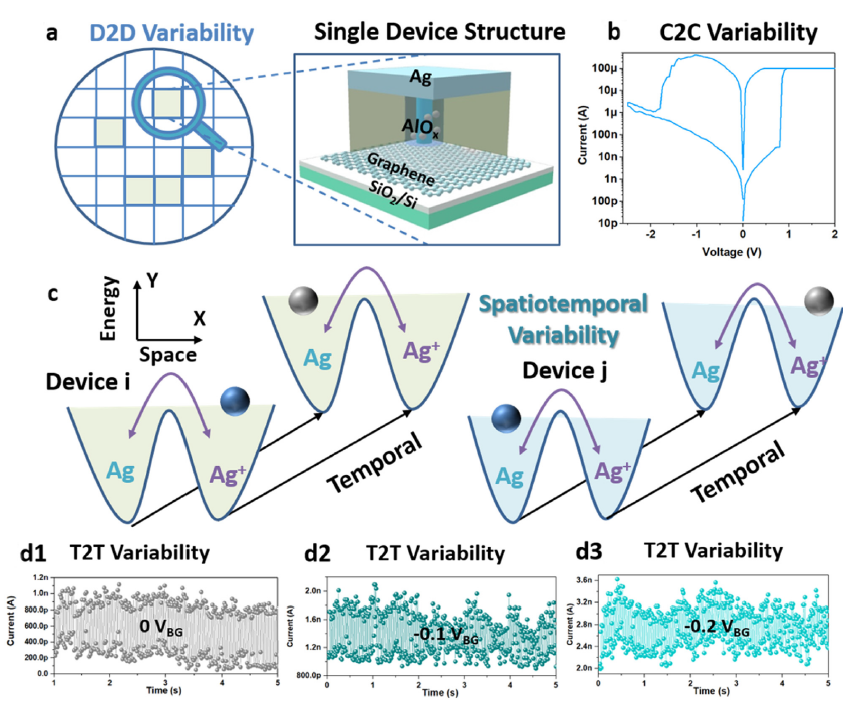Chip10 Science | 基于忆阻器时空变化的硬件物理熵源在密码学研究中的应用
FUTURE远见| 2024-04-10
Future|远见
Future|远见future选编
近日,北京工业大学微电子学院刘博、宾夕法尼亚州立大学Hanyuan Liang以「Implementing hardware primitives based on memristive spatiotemporal variability into cryptography applications」¹为题在Chip上发表研究论文,报道了一种基于忆阻器时空涨落作为物理熵源的随机数生成器,第一作者为刘博,通讯作者为刘博。Chip是全球唯一聚焦芯片类研究的综合性国际期刊,是入选了国家高起点新刊计划的「三类高质量论文」期刊之一。
从古代中国的「阴符」、古希腊的「斯巴达棒」、高卢战争中的凯撒密码、到二战时期的恩尼格玛密码机,加密技术的发展与进步确保了各种信息存储和传递的安全性²。不论是对称加密技术,还是现代密码学的非对称加密技术,随机数在各种加密系统中都扮演了重要的角色³。随机数可分为由软件算法产生的伪随机数和由硬件真随机数产生的真随机数。伪随机数的生成依赖于确定的算法,而基于物理熵源的真随机数生成器对于信息安全领域具有重要的学术价值和科学意义⁴。

图1 | 忆阻器的空间可变性。
相对于传统硅集成电路器件/芯片,忆阻器更具有内在的随机性⁵。因此,本研究基于忆阻器的时空涨落特性(图1),利用复合型的熵源生成随机数并应用在著名的非对称加密RSA算法当中。时空涨落的探讨分为器件间涨落,器件周期涨落与时间涨落(随机电报噪声)。结合蒙特卡洛仿真与人工智能分析技术(图2),研究者验证了忆阻器时空涨落作为熵源的随机性与独立性,开辟了利用主成分分析法(PCA)分析器件间涨落/长短期记忆-循环神经网络分析器件周期间涨落的新方法。

图2 | 基于人工智能的DDV和CCV分析。
本研究展示了基于忆阻器时空变化性生成的随机数的高度随机性。研究结果表明,由忆阻器硬件熵源生成的随机数在物理上不可预测,并能抵御机器学习类型的攻击,从而能够改善整个加密系统的鲁棒性。
Implementing hardware primitives based onmemristive spatiotemporal variability into cryptography applications¹
Implementing hardware primitive into cryptosystem has been a new tendency in the electronic community. Memristor, with intrinsic stochastic including the switching voltages, times and energies, as well as the fluctuations of the resistance state over time, could be a naturally good entropy source for cryptographic key generation. In this study, memristive spatiotemporal variability within graphene-based conductive bridging RAM (CBRAM) has been synergistically analyzed based on kinetic Monte Carlo Simulation, multiple Artificial Intelligence techniques, kernel density map and time constant analysis, which verified the inherent randomness of the memristive stochastic. Moreover, the random number based on hardware primitives passed the Hamming Distance calculation with high randomness and uniqueness and have been integrated into a Rivest-Shamir-Adleman (RSA) cryptosystem.
The security of the holistic cryptosystem relies on both the modular arithmetic algorithm and the intrinsic randomness of the hardware primitive. The spatiotemporal variability based random number is highly random, physically unpredictable and machine learning attack resilient, which improves the robustness of the entire cryptosystem.
参考文献:
1. Liu, B., Zhao, Y., Chang, Y. & Tai, H. H. Implementing hardware primitives based on memristive spatiotemporal variability into cryptography applications. Chip 2, 100040 (2023).
2. Carboni, R. & Ielmini, D. Stochastic memory devices for security and computing. Adv. Electron. Mater. 5, 1900198 (2019).
3. Pang, Y., Gao, B., Lin, B., Qian, H. & Wu, H. Memristors for hardware security applications. Adv. Electron. Mater. 5, 1800872 (2019).
4. Liu, B. et al. Bi2O2Se-based true random number generator for security applications. ACS Nano 16, 6847–6857 (2022).
5. Liu, B. et al. Memristive true random number generator with intrinsic two-dimensional physical unclonable function. ACS Appl. Electron. Mater. 5, 714–720 (2023).
论文链接:
https://www.sciencedirect.com/science/article/pii/S2709472323000035
关于Chip
Chip是全球唯一聚焦芯片类研究的综合性国际期刊,已入选由中国科协、教育部、科技部、中科院等单位联合实施的「中国科技期刊卓越行动计划高起点新刊项目」,为科技部鼓励发表「三类高质量论文」期刊之一。
Chip期刊由上海交通大学与Elsevier集团合作出版,并与多家国内外知名学术组织展开合作,为学术会议提供高质量交流平台。
Chip秉承创刊理念: All About Chip,聚焦芯片,兼容并包,旨在发表与芯片相关的各科研领域尖端突破性成果,助力未来芯片科技发展。迄今为止,Chip已在其编委会汇集了来自14个国家的70名世界知名专家学者,其中包括多名中外院士及IEEE、ACM、Optica等知名国际学会终身会士(Fellow)。
Chip第二卷第一期(2023年春季刊)于2023年03月在爱思唯尔Chip官网以金色开放获取形式(Gold Open Access)发布,欢迎访问阅读文章。
爱思唯尔Chip官网:
https://www.journals.elsevier.com/chip




